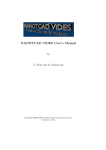Download Ocean Assimilation Kit (OAK) User guide
Transcript
Ocean Assimilation Kit (OAK) User guide Alexander Barth, Luc Vandenbulcke April 9, 2014 1 Structure of the software The software is structured in different modules • ufileformat: Binary output and input of large 1D, 2D or 3D matrices in the GHER or NetCDF. • initfile: Input of integers, floating numbers, strings and small vectors of those data types. • matoper: Basic matrix operating: multiplication, matrix inversion, eigenvalue/eigenvectors and singular value decomposition (relying on BLAS and LAPACK). • date: module for conversion between modified Julian day number and Gregorian date. • grids: interpolation from one grid to another of 1D, 2D or 3D data. • rrsqrt: The analysis equation • assimilation: I/O of state vector, observations, error space and observation operator. Analysis routine with input/output and computation of diagnostics. These modules can be either used for specific task with standalone programs 5 or by a hydrodynamic model in the case of a simulation assimilating observations. The GHER hydrodynamic model drives the data assimilation modules trough the following subroutines: • dainit: initialises of the data assimilation modules • daobs: loads of the next observation to assimilate • daanalysis: performs the analysis • damoderr: propagates the error covariance of the model 1 2 Module: ufileformat This module is used for binary output and input of large 1D, 2D or 3D matrices. The GHER and a subset of the NetCDF format is currently supported. The matrix can contain exclusion points (“holes”). Matrices A where the elements are a linear combination of the indices can also be efficiently represented: A(i, j, k) = a0 + a1 i + a2 j + a3 k (1) Only the coefficient a0 , a0 , a0 and a4 are stored. These file are called degenerated. For example, the longitude and latitude of each grid point can often be expressed in this way. For the GHER format, each file represent a real matrix. If the file names ends with .gz, then the file is uncompressed (with gunzip) in the user’s temporary directory defined by the environment variable $TMPDIR (or by default in /tmp). Simple Fortran 90-style extraction can also by performed with the module ufileformat. A coma separated list of indices or ranges of indices in parenthesis can be appended to the file name, if only a subsection of the matrix should be loaded. For example if the file toto.TEM is a 10 x 10 x 10 matrix, the “file”: toto.TEM(:,:,6) is 10x10x1 matrix containing all elements with the 3rd indices equal to 6. toto.TEM(:,end,:) is 10x1x10 matrix containing all elements with the 2nd indices equal to 10. toto.TEM(1:,:end,1:end) is 10x10x10 matrix equal to the original matrix But no arithmetic with the indices (for example toto.TEM(:,end-1,:)) are allowed. If data extraction is used with degenerated matrices, the four coefficient are changed accordingly to the subsection chosen. Data extraction and automatic decompression can only be used for loading data. A variable in a NetCDF file can be loaded by specifying a “file name” of the following form: NetCDF_filename#NetCDF_variable If the NetCDF file name end with .gz, then the file is uncompressed as with the GHER file format. The data extraction follows also the same rules as above. For example, the following is a valid file name for loading a matrix. file.nc.gz#temp(:,:,1) The file file.nc.gz is first decompressed, then the slice with the 3rd indices equal to 1 of the variable temp is returned to the calling program. The special value for missing data is stored in the variables attribute missing data. In the case of degenerated file, the attribute shape must be present, containing the shape of the matrix. The actual value of the variable contains the coefficients ai . 2 2.1 Order of the dimensions The reported order of the dimensions depends on the tool that you are using to query and access a file. Two types of ordering schemes exists: column-major order : used by Fortran programs such as OAK row-major order : used by C programs such as ncdump The order of the dimensions for NetCDF follows the recommendation of the CF-convention. If you query your NetCDF files with ncdump, the order of the dimensions should be time, depth, latitude, longitude. For a Fortran program reading this file the dimensions with automatically be longitude, latitude, depth and time since Fortran uses the column-major order (as opposed to ncdump). For Fortran binary files, the order of the dimensions is also longitude, latitude, depth and time. 3 The initialisation file With the module initfile a program can read an integer number, floating number or a character string from an initialisation file. Each line in this file is composed by a name (called key), an equal sign and the value. For example: runtype = 2 Geoflow.maxU = 0.3 logfile = ’assim.log’ When the program search for example the key “runtype”, it gets the integer 2. If a key is present several times in the same initialisation file, then the last value found is taken. The key can be composed by any alphanumeric character and by periods (.). In particular, spaces and a equal signs are not allowed within the key name. The wild cards symbols *, ? and brackets ([,]), are allowed but have a special meaning (see Paragraph below). Vectors of integers, floats and character strings are also supported. The values are separated with commas and enclosed in brackets. Model.variables = [’ETA’,’TEM’,’SAL’] Model.maxCorrection = [0.3,3.,2.,0.3,3.,2.,0.3,3.,2.] Blank lines are ignored and comments begin with the pound sign (#). It is recommended to document the meaning and the possible values by a comments directly in the initialisation file. Entries in this files cannot be split across different lines. Before assigning a value to a key you should know with type is expected: scalar or vector and number or characters. If the type does not correspond, the program will be stopped. Sometimes a sequence of keys are attributed to the same values: 3 Obs001.path Obs002.path Obs003.path = ’/u/abarth/soft/Ligur3/Obs/’ = ’/u/abarth/soft/Ligur3/Obs/’ = ’/u/abarth/soft/Ligur3/Obs/’ In this case one can use wild cards and write the following: Obs*.path = ’/u/abarth/soft/Ligur3/Obs/’ The meaning of the wild cards are the same as for file name generation of the Burne Shell (see also man page of sh and gmatch). 4 4.1 Assimilation module Reduced order analysis Let N be the ensemble size, n the size of the state vector and m the observation space dimension. The best linear unbiased estimator (BLUE) of the model’s state vector given the model forecast xf with error covariance Pf and the observation yo with error covariance R is given by xa : xa = xf + K yo − Hxf K = Pf HT HPf HT + R (2) −1 Pa = Pf − KHPf (3) (4) where H is the observation operator extracting the observed part of the state vector and Pa the error covariance of the analysis xa . (k) From the ensemble of forecast states xf where k = 1, . . . , N one can compute the ensemble mean xf = N 1 X f (k) x N k=1 (5) and ensemble covariance: N (k) T 1 X f (k) x − xf xf − xf P = N − 1 k=1 f (6) We construct the columns of the matrix Sf by: (k) f S k xf − xf = √ N −1 (7) where Sf is a n×N matrix, which each column being the difference between each member its ensemble mean. Its mean over all columns it thus zero. As many other assimilation schemes (SEEK, RRSQRT, ESSE, EnKF), Pf is decomposed in terms of this square root matrix Sf : T Pf = Sf Sf (8) 4 Typically, the number of ensemble members N is much smaller than the state vector size n. We rewrite the Kalman Filter analysis, by avoiding any matrix of the size n × n: h i−1 T T K = (Sf Sf )HT H(Sf Sf )HT + R −1 = Sf (HSf )T HSf (HSf )T + R −1 (HSf )T R−1 = Sf I + (HSf )T R−1 HSf (9) (10) (11) Where the Sherman-Morison-Woodbury identity has been applied from (10) to (11). This identity can be expressed as: ABT C + BABT −1 −1 = A−1 + BT C−1 B BT C−1 (12) with A = I, B = HSf , C = R. That is, instead of performing the inverse in space of matrix A the inverse is done in the space of the matrix C. We also substitute Pf in the expression of the analysis covariance error Pa : Pa = Pf − KHPf f fT f fT (13) f fT − KHS S −1 T = S S − Sf I + (HSf )T R−1 HSf (HSf )T R−1 HSSf h i T −1 = Sf I − I + (HSf )T R−1 HSf (HSf )T R−1 HS Sf = S S (14) (15) (16) In order to avoid to form Pa explicitly, we need to express Pa also in terms of the square root matrices Sa . Pa = Sa SaT (17) This is possible when the following eigenvalue decomposition is made : HSf T R−1 HSf = UΛUT (18) where UT U = I and where Λ is diagonal. U and Λ are both of the size N × N . Using the decomposition (18) in equation (16) one obtains: T Pa = Sf I − (I + UΛUT )−1 UΛUT Sf T = Sf I − (I + UΛUT )−1 UΛUT + I − I Sf T = Sf I − (I + UΛUT )−1 UΛUT + I + (I + UΛUT )−1 Sf T = Sf I − I + (I + UΛUT )−1 Sf = Sf (I + UΛUT )−1 Sf f T = S (UU + UΛU ) S f −1 f −1/2 T (I + Λ) (21) (22) (24) fT = S U(I + Λ) U S = S U(I + Λ) (20) (23) T −1 f T T (19) (25) −1/2 5 T U S fT (26) So we found a square root decomposition of Pa in terms of Sf U(I + Λ)−1/2 . But in order to construct an ensemble from the columns of Sa , its mean has to be zero. So we will transform Sa so that the identity (26) is preserved. One way to do this is Sa = Sf U(I + Λ)−1/2 UT Ω (27) The decomposition (18) can also be used in the computation of the Kalman gain K: by: −1 (HSf )T R−1 K = Sf I + (HSf )T R−1 HSf −1 = Sf UUT + UΛUT (HSf )T R−1 −1 f T f T = S U(I + Λ) U (HS ) R (28) (29) −1 (30) a Ω is an orthogonal matrix chosen such that sum of all columns of S is zero. This sum can be obtained by multiplying to the right with a vector N × 1 with all elements equal to 1 (IN ×1 ). Since Sf IN ×1 is zero, Sa IN ×1 is also zero if: U(I + Λ)−1/2 UT Ω IN ×1 = IN ×1 Ω IN ×1 = U(I + Λ)1/2 UT IN ×1 (31) (32) We defined the normalised vectors w and v: 1 w = √ IN ×1 N v = αU(I + Λ)−1/2 UT IN ×1 (33) (34) Ω is thus a matrix which rotates w onto v. Ωw = v (35) It can be computed by: Ω = vwT + H(v)H(w)T (36) where H(v) is the N × (N − 1) Householder matrix associated to the vector v, i.e. all columns of H(v) are vectors perpendicular to v (Hoteit et al., 2002): vi vj for i ≤ N − 1 |vN | + 1 (vN + sgn(vN ))vj = − |vN | + 1 H(v)i,j = δi,j − H(v)N,j (37) (38) Sa is the square root of Pa : Pa = Sa SaT a (39) a Based on x and S , an ensemble can be reconstructed: xa(k) = xa + √ N − 1 Sa(k) (40) The bias aware analysis scheme of Dee and Silva (1998) is also implemented. But the error space Sa is not computed. 6 4.2 Configuration The initialisation file of the assimilation module is composed mainly by four sections: configuration of the model (model state vector, position of the individual variables, error space of the model), observations to assimilate (observations, their position, their error), eventual diagnostics of the analysis and miscellaneous flags. 4.2.1 The model The following code contains the definition of the multivariate state vector. The key Model.variables is a vector of character strings attributing to each variable a user chosen name. The keys Model.gridX, Model.gridY, Model.gridZ and Model.mask are vectors of file names. The files in Model.gridX and Model.gridY are degenerated and give the longitude and latitude of each variable. The files in Model.gridZ can be plain files and contains the depth. The key Model.mask is used to determine the sea-land mask of each variable. The exclusion value (or missing value or FillValue in NetCDF terminology) marks a land point all other values, a sea points. Every files assembled into a state vector should have physical values where mask assumes a sea point. The shape of the arrays in Model.gridX, Model.gridY, Model.gridZ and Model.mask must be the same. The string in Model.path in prepended to each file names. Example: Model.variables Model.gridX Model.gridY Model.gridZ Model.mask Model.path = = = = = = [’ETA’ ,’TEM’ ,’SAL’] [’ligur.X(:,:,end)’,’ligur.X’,’ligur.X’] [’ligur.Y(:,:,end)’,’ligur.Y’,’ligur.Y’] [’ligur.Z(:,:,end)’,’ligur.Z’,’ligur.Z’] [’ligur.Z(:,:,end)’,’ligur.Z’,’ligur.Z’] ’/u/abarth/soft/Ligur3/Data/’ For nested grids the variables of the same nested must be grouped and the groups must be orders according to the resolution started with the highest resolution one. To each model grid is associated a Model.gridnum: one for the highest resolution one, two of the next highest resolution one and so one. Model.variables Model.gridX Model.gridY Model.gridZ Model.mask Model.gridnum Model.path = = = = = = = [’TEM’ ,’SAL’ ,’TEM’, ’SAL’] [’ligur.X’,’ligur.X’,’med.X’,’med.X’] [’ligur.Y’,’ligur.Y’,’med.Y’,’med.Y’] [’ligur.Z’,’ligur.Z’,’med.Z’,’med.Z’] [’ligur.Z’,’ligur.Z’,’med.Z’,’med.Z’] [ 1, 1, 2, 2] ’/u/abarth/soft/Ligur3/Data/’ Mandatory keys 7 Key ErrorSpace.dimension ErrorSpace.init Type integer vector of strings Description The dimension of the error space. Each string is a Fortran format containing an integer descriptor. The format is converted into a file name with an internal write. The integer is a number ranging from 1 to the dimension of the error space n. n vectors of file names are formed and represent a error mode in the state space. Their norm represent the importance of the error mode and thus they are in general not normed. Orthogonality is not necessary. Key ErrorSpace.path Type string ErrorSpace.scale real ErrorSpace.spaceScale vector of strings Description The path is prepended to all file names specified in ErrorSpace.*. The current path is used by default. Each error mode is multiplied by this real number. The default is 1. Each error mode is multiplied element by element by this vector. The default is a vector with all elements equal to 1. Optional keys 4.2.2 Zones When the local version of the assimilation algorithm (schemetype = 1) is used, then the assimilation is performed in a number of zones independently. Zones are defined by specifying a partition vector which has the same number of variables as the model state vector and each variable has the same size as the corresponding Model.mask. This vector contains only integer values starting with one and represent labels: all elements in the state vector which have the same partition number belong to the same zone. For example, for a state vector with 5 elements and the partition vector p: x1 1 1 x2 2 x p = (41) x= 3 x4 2 x5 3 This partition vector defined three zones: the first zone contains elements x1 and x2 , the second zone x3 and x4 and the third zone x3 . There should be no gaps in the partition vector. For example the vector (1, 1, 2, 2, 4)T would cause an error. In practice, the state vector is partitioned along water columns. The assimilation is performed independently in each zone using only observations within the search radius given by Zones.maxLength. 8 The weight of the observations 1 R0 is multiplied by a Gaussian function: 1 1 = 0 exp(−(d/L)2 ) 0 R R (42) where d is the horizontal distance (in m) the first point of a zone and a single observation and L a length-scale (in m) given by Zones.corrLength. Zones.maxLength and Zones.corrLength have the same size as the model state vector. In most cases these values are constant can be specified by, e.g.: Zones.corrLength.const = [ Zones.maxLength.const = [ 30e3, 2000e3, Key Zones.partition Type vector of strings Zones.corrLength vector of strings Zones.maxLength vector of strings 4.2.3 30e3] 2000e3] Description Each string is a file name containing the partition file for the given model variable Each string is a file name containing the correlation length Each string is a file name containing the maximum correlation length The observations All set of simultaneous observation are ordered chronically and are attributed to a time index starting with 001 (written always with three digits). In the following keys “XXX” have to be replaced by the time index. Mandatory keys Key ObsXXX.time Type ’yyyy-mmddTHH:MM:ss’ ObsXXX.value vector of strings ObsXXX.rmse vector of strings ObsXXX.mask vector of strings Optional keys 9 Description yyyy=year (minimum 1 digit integer) mm=month (2 digits integer) dd=day (2 digits integer) HH=hour (2 digits integer) MM=min (2 dig-ids integer) SS=second (minimum 1 digit integer or real) Each string is a file name containing the actual values of the observations Each string is a file name containing the root mean square error of the observations. Each string is a file name containing the binary mask of the observations. Values where the mask is different from 1 are rejected. Key ObsXXX.variables Type vector of strings Description The names must correspond to the names chosen in Model.variables. Unknown names are treated as ”out of the grid” and are not assimilated. ObsXXX.names vector of strings Each string is a description of the data type of the observations. You can choose any name meaningful to you. These names are only used for the log-file. The default names are Var01, Var02,... ObsXXX.gridX vector of strings Each string is a file name containing the longitude of the observations. ObsXXX.gridY vector of strings Each string is a file name containing the latitude of the observations. ObsXXX.gridZ vector of strings Each string is a file name containing the depth of the observations. ObsXXX.HperObs vector of strings The observation operator stored in a sparse matrix form per observations ObsXXX.operator string The observation operator stored in a sparse matrix form. ObsXXX.path string The path is prepended to all file names specified in ObsXXX.*. The current path is used by default. The optional keys are used to create the observation operator. If it is applied to the state vector, it extracts the observed variables at the location of the measurements. Several ways exist to specify the observation operator. 1. ObsXXX.operator: the observation operator is directly given by the non zero elements. See also 4.2.3. 2. ObsXXX.variables and ObsXXX.HperObs: the non zero elements of the observation operator for each variable are given separately. The first column in 9 × x matrix is ignored. See also 4.2.3. 3. ObsXXX.variables, ObsXXX.gridX, ObsXXX.gridY and ObsXXX.gridZ: the observation operator is created by a trilinear interpolation using the module grids. Note that the individual arrays in ObsXXX.value, ObsXXX.rmse, ObsXXX.mask, ObsXXX.gridX, ObsXXX.gridY and ObsXXX.gridZ should have the same size. Format of the observation operator Only the non-zero elements of the observation operator are specified in the 9 × n matrix (in column-major order) where n is the number of non-zero elements. Each column has the following structure: 10 var. index Observations i-index j-index k-index var. index Model i-index j-index k-index Interpolation coefficient The first integer value is related to the observation. The index of the variable is the position where the observed variable appears in ObsXXX.value and i,j,k-index are the three spatial indexes of a single scalar observation. The integers in column 5 to 8 are related to the model state vector. Again the index of the variable is the position where the observed variable appears in Model.variables and i,j,k-index are the three spatial indexes of a single scalar model forecast. If one of the model indexes is -1 the corresponding observation is treated ”out of grid” and the associated weight will be zero. The column 9 is a real value between 0 and 1 in the case of a simple trilinear interpolation. The observation operator can be generated offline using a trilinear interpolation with the tool ”genobsoper”. 4.2.4 Diagnostics All diagnostics are optional and the corresponding files are output. 11 Key DiagXXX.xf DiagXXX.Hxf DiagXXX.Sf Type vector of strings vector of strings vector of strings DiagXXX.Ef vector of strings DiagXXX.diagPf vector of strings DiagXXX.diagHPfHT vector of strings DiagXXX.stddevxf vector of strings DiagXXX.stddevHxf vector of strings DiagXXX.path string DiagXXX.xa DiagXXX.Hxa DiagXXX.Sa vector of strings vector of strings vector of strings DiagXXX.Ea vector of strings DiagXXX.diagPa vector string DiagXXX.diagHPaHT vector of strings DiagXXX.stddevxa vector of strings DiagXXX.stddevHxa vector of strings DiagXXX.H DiagXXX.yo DiagXXX.invsqrtR strings vector of strings vector of strings DiagXXX.xa-xf DiagXXX.yo-Hxf vector of strings vector of strings 12 DiagXXX.yo-Hxa vector of strings DiagXXX.Hxa-Hxf DiagXXX.path vector of strings string Description the model forecast (ensemble mean) the observed part of the model forecast Each string is a Fortran format. For the conversion into file names see the key ErrorSpace.init. The files represent the error modes of the model forecast. Each string is a Fortran format. For the conversion into file names see the key ErrorSpace.init. The files represent the forecast ensemble. The diagonal elements of error covariance of the model forecast. The diagonal elements of error covariance of the observed part of the model forecast Standard deviation of the error of the model forecast. Standard deviation of the error of the observed part of the model forecast. The path is prepended to all file names specified in DiagXXX.*. The current path is used by default. the analysis (ensemble mean) the observed part of the analysis Each string is a Fortran format. For the conversion into filenames see the key ErrorSpace.init. The files represent the error modes of the analysis. Each string is a Fortran format. For the conversion into file names see the key ErrorSpace.init. The files represent the analysis ensemble. The diagonal elements of error covariance of the analysis. The diagonal elements of error covariance of the observed part of the analysis Standard deviation of the error of the analysis. Standard deviation of the error of the observed part of the analysis. the observation operator The observations. The inverse of the root mean square error of the observations. If a scalar observation point has been eliminated (out of the model grid for example) its weight is zero. The analysis increment the observation minus the model forecast at the observation points the observation minus the model analysis at the observation points analysis increment at the observation points The path is prepended to all filenames spec- 4.2.5 miscellaneous flags Key nbnest assimnum Type integer integer runtype integer Description Number of nested grids Number between 1 and nbnest different for each model. The model with assimnum does the assimilation possible values of runtype are: 0: do nothing, i.e. a pure run of the model 1: still do not assimilate, but compare model to observations 2: assimilate observations schemetype integer possible values of schemetype are: 0: global assimilation (default) 1: local assimilation (Zones need to be defined) moderrtype integer possible values of moderrtype are: 0: optimal interpolation Pf constant 1: forgetting factor approximation biastype integer possible values of biastype are: 0: standard bias-blind analysis 1: A fraction of the error (gamma) is a systematic error and the rest (1-gamma) is random (Dee and Silva, 1998) Bias.gamma Bias.init joinvectors real vector of string integer logfile string debugfile string 13 fraction of the error with is systematic the initial estimation of the bias If joinvectors is 1 then the variables of the nested grids will be assembled to one multigrid state vector File contains simple diagnostics such as rmse with observations File contains debugging information is the code was compiled with the flag -DDEBUG 5 5.1 Standalone programs Program assim The standalone program assim can be used to test the assimilation. The program can be called from the command line: assim <initfile> <time index> The first argument is the initialisation file and the second argument is the time index of the observation to assimilate. All keys described in 4.2 have the same meaning for the program assim. But the forecast has to be specified by the following keys. Key Type Description ForecastXXX.value vector of strings the forecast ForecastXXX.path string The path is prepended to all filenames specified in ForecastXXX.value. The current path is used by default. If the program is called with three arguments: assim <initfile> <start time index> <end time index> All assimilation cycles be between the two time indexes are performed in chronological order. 5.2 Program genobsoper The standalone program genobsoper generate the observation matrix. genobsoper <initfile> <time index> The first argument is the initialisation file and the second argument is the time index of the observation for witch the observation operator has to be created. All keys described in 4.2 have the same meaning for the program genobsoper. But the only diagnostic key used is DiagXXX.H. If the program is called with three arguments: genobsoper <initfile> <start time index> <end time index> The action is repeated for all time indexes between the start and the end time index. 5.3 Program applyobsoper The standalone program applyobsoper extracts from a state vector the observations. applyobsoper <initfile> <time index> 14 The first argument is the initialisation file and the second argument is the time index of the observation for witch the observation operator has to be created. All keys described in 4.2 have the same meaning for the program applyobsoper. But the only diagnostic key used are DiagXXX.Hxf and DiagXXX.invsqrtR. If a scalar observation point has been eliminated (out of the model grid for example) its weight in DiagXXX.invsqrtR is zero. The state vector is specified as it is described in 5.1. If the program is called with three arguments: applyobsoper <initfile> <start time index> <end time index> The action is repeated for all time indexes between the start and end time index. 5.4 Program filteroper The standalone program filteroper generates a sparse matrix witch acts as a spatial filter in the model space. filteroper <initfile> For each variable the filter is a Gaussian function: 0 0 0 f (x, y, z, x , y , z ) = N e − (y−y 0 )2 (z−z 0 )2 (x−x0 )2 − − L2 L2 L2 x y z (43) N is a normalisation factor taking in to account the land-sea mask. The parameters Lx , Ly and Lz may be space dependent and have thus the same dimension as the state vector. The required keys are: Key Model.mask Model.gridX Model.gridY Model.gridZ Model.path Type vector vector vector vector string Correlation.lenx Correlation.leny Correlation.lenz Correlation.path vector of strings vector of strings vector of strings string Filter string 5.5 of of of of strings strings strings strings Description sea-land mask of each variable longitude of each variable (degenerated file) latitude of each variable (degenerated file) depth The path is prepended to all filenames specified in Model.*. The current path is used by default. parameter Lx in equation 43 parameter Ly in equation 43 parameter Lz in equation 43 The path is prepended to all filenames specified in Correlation.*. The current path is used by default. file name of the filter Program opermul opermul is a general purpose program witch multiply two sparse operators. It can be used for example for multiplying a filter operator and a observation operator. O3 = O2 O1 15 (44) O1 is a operator mapping from space S1 to S2 , O2 from S2 to S3 and thus the product from S1 to S3 . opermul <initfile> The required keys are: Key Space1.mask Space1.path Type vector of strings string Space2.mask Space2.path vector of strings string Space3.mask Space3.path vector of strings string Term1 Term2 Product string string string 5.6 Description sea-land mask of space S1 The path is prepended to all filenames specified in Space1.mask. The current path is used by default. sea-land mask of space S1 The path is prepended to all filenames specified in Space2.mask. The current path is used by default. sea-land mask of space S1 The path is prepended to all filenames specified in Space2.mask. The current path is used by default. file name of operator O1 file name of operator O2 file name of the product O3 Matlab utility GenObsFile The utility ”GenObsFile” provides an easy way to save all the observations, coming from various sources, in a few files with the NetCDF format, and creates the .INIT file required by the assimilation routines. Options for GenObsFile must be specified in the header of the Matlab routine, as described below: • initheader: complete path & file name, of the file that must be copied on top of the .INIT file. This could be the ”model” part of the .INIT file. • diags: complete path & file of a sample ”diagnostic” part of the .INIT file. The observation number should be replaced with <INDEX> and variable names with <EXT>. This part will be (adapted and) copied for each observation set. Example: Diag<INDEX>.Hxf = [’xf.<EXT>’] • Outdir : path where to store the new observations and .INIT file. • Outfile : prefix of the new observation files • maxX, minX, maxY, ..., minMJD: observations not within these ranges will be ignored when creating the new observation files 16 • rmse : vector containing errors on the observations, in the following order: [TEM SAL ETA other]=[...] It will only be used by the assimilation routine if no other observation error covariance R matrix is specified. GenObsFile only uses values corresponding to variables present in your observations list. • obstime : time of the day at which observations should be assimilated • listfile : complete path+file name for the listfile, which contains the original observations. It is build using sections. There must be at least one section in the listfile. Each section contains a ”config” line followed by an arbitrary amount of data lines. The config line starts with the keyword ’config’, and has the following format: config VAR X Y Z MJD – VAR indicates how the observed data should be named in the .INIT file (TEM ...) – X might be (a) a complete path+file name with the longitude data, corresponding to the observations, (b) the keyword ’file’ if the longitude data is written in a file with the same file name as the actual data, with extension .X – Y (idem) – Z (idem) – MJD points to the file containing the MJD-time corresponding to the – observations, and might be (a) a complete path+file name, (b) the – keyword ’file’, (c) a datum in the format 1999-12-31, (d) a datum in – the MJD format ’51251’, (e) character limits to be found in the – actual observations file name. For example, if the actual file name is /home/johndoe/51657.TEM , MJD could be 15-19 as those are the indexes pointing to 51657 in the file name. After each config line, an arbitrary amount of observation files may be given. The filenames may contain matrix delimiters, as in (1:100,2:5,:) Example listfile: 17 config TEM ./Lion.X ./Lion.Y ./Lion.Z 1998-01-01 /home/johndoe/observations/Lion00000480.TEM.gz(:,:,end) config SAL ./Lion.X ./Lion.Y ./Lion.Z 1998-01-01 /home/johndoe/observations/Lion00000480.SAL.gz(:,:,end) config TEM file file file file /home/johndoe/observations/ctd02.1_03_aug_2241.TEM /home/johndoe/observations/ctd03.1_03_aug_1840.TEM /home/johndoe/observations/ctd04.1_04_aug_0747.TEM config TEM ./ligur.SST.X ./ligur.SST.Y ./ligur.SST.Z 32-41 /scratch/johndoe/observtn/ligur1999-07-02.SST.gz /scratch/johndoe/observtn/ligur1999-07-03.SST.gz /scratch/johndoe/observtn/ligur1999-07-04.SST.gz /scratch/johndoe/observtn/ligur1999-07-10.SST.gz /scratch/johndoe/observtn/ligur1999-07-11.SST.gz 6 6.1 API ufileformat uload(filename,matrix,exclusion value) filename : character of strings, input. The filename of the matrix to load with the extensions described in 2. matrix : 1D, 2D or 3D unallocated real pointer, output. The allocation of the output matrix is done inside the subroutine. exclusion value : real, output: The exclusion value usave(filename,matrix,exclusion value) filename : character of strings, input. The filename of the matrix to save. matrix : 1D, 2D or 3D real matrix, input. The matrix to save. exclusion value : real, input: The exclusion value References D. P. Dee and A. Silva. Data assimilation in the presence of forecast bias. Quarterly Journal of the Royal Meteorological Society, 124:269–295, 1998. I. Hoteit, D.-T. Pham, and J. Blum. A simplified reduced order Kalman filtering and application to altimetric data assimilation in Tropical Pacific. Journal of Marine Systems, 36:101–127, 2002. 18



























